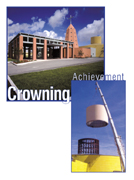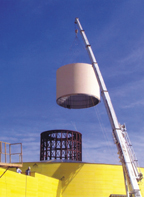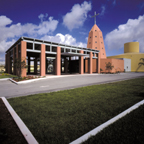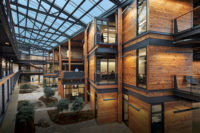

The fact is, creative contracting was needed on the church in order to bring the imaginative design of world-renowned architect, Michael Graves, from drawing to reality.
The church, which will serve as the parish church for a large congregation in central Florida, is located on a 40-acre site adjacent to a small school and convent. The project includes a 1,200-seat main assembly space and a 130-seat daily chapel.

Heavenly design
The design of the church, which comprises a series of elements along a linear axis, symbolizes the pilgrimage, an important metaphor in Catholic teaching. The site design further emphasizes the linear axis of the church, extending beyond the building through an open roofed space and along the processional way, an outdoor walk lined by the "Stations of the Cross.""The idea was to translate the concept of the pilgrimage into an architectural metaphor, so that each event that occurs becomes part of the building," says John Diebboll, principal with the architectural firm of Michael Graves and Associates in New York City. "This concept begins with the arrival of the congregants coming to mass, where they pass through a 6,000 square-foot covered open entry, and then move along the processional way. The theme is carried along the entire length of the church."
The several different elements of the building are articulated as geometrically distinct forms. Their individuality is further emphasized by the use of color. The first enclosed space congregants reach is the 4,000 square-foot narthex, an octagonal area which becomes the base of the 65-foot-tall bell tower, reminiscent of the church steeples found on traditional Christian churches. This serves as the foyer or entrance to the church, and is surrounded by support space, such as restrooms, the sacristy, a small meeting room, and a practice room for the choir.
A hallway with a low ceiling leads into the main assembly area of the church. On either side of the hallway are two rooms: the reconciliation chapel and the devotional chapel.
At the end of the hallway is the 16,000 square-foot main assembly, which gathers the congregation into a space where all participate in the celebration of the mass. Its circular form creates a single space for both congregation and celebrant, embodying the theology that the church is created by the active participation of all congregants in the mass.
Set within the circle of the main assembly is an octagonal framework that creates an open hallway around the perimeter of the space, with all seats focused toward the center of the room. The space is highlighted with a large skylight, or clerestory, which is focused on the priest, who stands at the altar at the far end of the octagon.
From the outside of the church, each of these rooms can be identified by their geometric shape and size, as well as through the use of a different color for each section of the building.
The church was constructed with a structural steel framework to support the taller structures, such as the bell tower and the main, dome-topped assembly area, and was clad with EIFS and metal stud framing.
"EIFS is a system that has worked well for us in the past," says Diebboll. "It works particularly well for the various geometric forms we incorporate in our designs, which tend to have minimal details. The emphasis is more on the proportions of the building elements themselves and how they relate to each other in terms of color, light and shadow. EIFS gives us a freedom of design with an endless possibility in colors, details, form and texture. For the owner, EIFS provides a blanket of continuous insulation, and enables excellent strength-to-weight ratios. So, in terms of both aesthetic and practical considerations, it has turned out to be an excellent system for our projects."
"It was a complicated building in terms of design," says Charlie Murray, vice president of W&J Construction Corporation in Cocoa, Fla. "The main assembly consists of a great deal of open space, and was built somewhat like an enclosed sports stadium-a standard steel beam and truss-type building with a tension ring. But the various geometric shapes comprising all the different parts of the building meant there had to be a lot of versatility in the cladding. The steel studs and EIFS provided that versatility."
Divine construction
Naturally, erecting the red iron structural steel framework of the church was the first step in the actual construction of the building. Acousti Engineering Company of Orlando, Florida, was awarded the EIFS, drywall and metal studs contract in April 2001. At that time, the structural steel was almost complete, but the concrete slab was another two months from being poured and finished. That's when Acousti made the decision to panelize the job-actually beginning the external EIFS portion before the slab was even started or all the structural steel in place."The main components we pre-assembled were the wall panels for the main assembly, the cupola and the tower (eventually, a total of about 40,000 square feet of EIFS)," says Don Verner, vice president and general manager of Acousti Engineering. "We actually began panelizing the walls and the cupola while the other contractors finished with the structural steel and poured the slab. Later, we began prefabrication of the tower as well. This method of constructing the components on the ground while other work was still underway gave us a great head start on the job."
The main assembly is a round structure, 480 square feet in circumference, that rises 29 feet high. Acousti began pre-assembling wall panels in 10-foot sections, consisting of 6-inch, 16-gauge metal studs and sheathing.
The EIFS panels were constructed by attaching Dens-Glass Gold sheathing to the metal studs. Manufactured by G-P Gypsum Corp., Dens Glass Gold sheathing is a paperless sheathing panel engineered with a proprietary water-resistant treated core, and surfaced with glass mat facings and a gold-colored, bond-enhancing primer coating. It was created to withstand weather and moisture exposure when installed in EIF systems.
"It took us about a month to build all the panels for the sanctuary section of the church-pre-forming the steel studs and applying the Dens-Glass to them," says Verner. "Once the slab was poured, we actually set all those panels in one day, using a small crane."
This sheathing formed the base for the Essence EIF system, manufactured by Sto Corp., which was applied once the panels were set in place.
First, all the sheathing joints and rough openings were treated with Sto Detail Mesh, a lightweight, flexible reinforcing fabric specially designed for use to facilitate back-wrapping system termination into reveals and to bridge sheathing joints and wrap rough openings. This was covered with the company's Gold Fill product, a trowel-grade, ready-mixed flexible joint compound material applied to rough openings and sheathing joints. Then, Sto's Gold Guard liquid-applied building wrap product was applied over the entire surface.
"Gold Guard has been available for quite awhile now, and it's really started to take off," says Tim Salerno, senior sales representative for Sto Corp. "It's a roller-applied membrane, as opposed to a trowel-applied product, which makes the application much quicker. As a secondary moisture barrier system, it forms a waterproof barrier that protects the sheathing during construction as well as when the building is finished. I think contractors find this especially useful in climates such as Florida, which typically has a heavy summertime rainy season."
Foam insulation was applied to the Gold Coat system with vertical ribbons of adhesive, which allows incidental moisture to escape and drain through weep holes at the bottom of the system. Sto's Essence system then allows for a number of finishes to be applied over the system's basecoat.
The cupola capping off the assembly area, on the other hand, was completely fabricated in the church's parking lot, including the final base coat and finish coat. It then had to be hoisted to the top of the church to the existing red iron, 65 feet above the finish floor.
"We got some skeptical looks when we first proposed this method of constructing and placing the cupola," admits Verner. "There were worries about the finish on the dome cracking, or the steel becoming distorted during the lifting process. Since all measurements had to maintain their dimensions within one inch to fit properly on the existing red iron, I really couldn't blame them for fearing the possibility of failure."
Verner allayed those fears by pointing out that synthetic EIFS finishes are virtually impervious to cracking due to their elasticity. When a specially-constructed harness was also proposed for the lifting part of the undertaking, Acousti was given the green light.
"We didn't have much choice at that point," says Verner. "It was either do it this way, or wait up to two months for the slab to be completed."
Constructing the dome at the top of the building prior to completion of the slab would have meant setting scaffolding 65 feet high all the way around the building. Not only would this have meant trying to set the scaffolding in the dirt, it also meant they would have been in the way of the concrete contractors trying to finish the slab.
In order to lift the cupola in place, 32 brackets, or pick points, were incorporated in 20-foot lengths around the dome. These were connected by cables to one main assembly, which the crane could pick up in order to lift the structure into place.
When all was said and done, the cupola was picked up off the ground and and all 17,000 pounds lifted into place with a good 1/2 inch to spare on its 1-inch maximum clearance specification.
Besides saving up to two months in construction time, Verner says his company also saved about $5,000 in scaffolding costs.
"I think all would agree this was the way to go," he says.
All would also agree that everyone involved in the design and construction of the finished church can be very proud of the results.
"It's been quite a project," says W&J Construction's Charlie Murray. "Once we're finished, I think everyone's going to be proud of it, and will be glad to have been part of the construction team that built it."W&C


Report Abusive Comment